
Types of Batteries
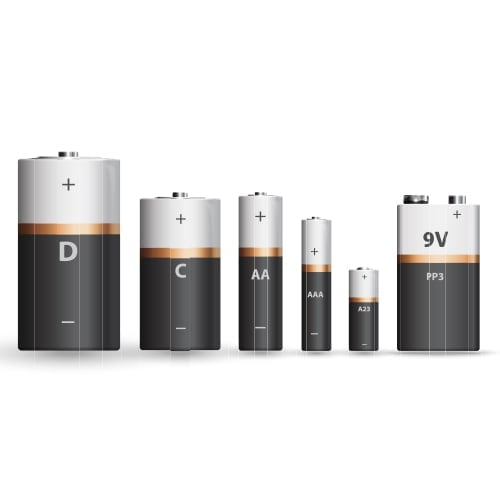
Different Battery Sizes
Different battery sizes contribute to the overall effectiveness of your equipment, but it is important to understand why. Generally, the larger the battery is, the more capacity it has for energy storage. So even though a big and small battery are both rated at 1.5V, the big battery stores more energy and provides a longer battery life. Batteries are extremely useful to us as consumers because they convert stored chemical energy into electrical energy, eliminating the need for a direct power source.
Common Battery Sizes
From thermometers and timers, to automatic paper towel dispensers and neon signs, batteries are employed in some capacity in almost every environment. Although all batteries serve the same purpose of providing us with instant, portable power, a large selection of different sized batteries allows us to find the one that best suits a specific circumstance.
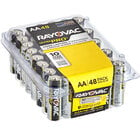
AA Batteries
Also known as “double A”, AA batteries are by far the most popular battery size. Used in a multitude of applications, these batteries can be purchased almost anywhere.
Double A batteries are generally what everyone pictures when they think of standard replaceable batteries. Used in everything from thermometers and staffing pagers to cordless phones, these batteries are used extensively. AA batteries measure at 1.5V, and work well for devices that require a somewhat high current draw, but are not in constant use. They can also be used for devices like clocks that are always on but use minimal energy.
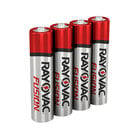
AAA Batteries
Also known as “triple A”, AAA batteries are the second most popular kind of battery. They are used for small toys, thermometers, and calculators.
Triple A batteries are often used for small electronic devices such as TV remote controls, kitchen timers, graphing calculators, and bathroom scales. AAA batteries, like AA batteries, also measure at 1.5V, but generate less energy due to their smaller size. These batteries are used primarily in small devices that don’t require a lot of energy, like kitchen timers. The batteries will last a long time, while still accomplishing their purpose. These compact batteries also power portion control scales and thermometers.

AAAA Batteries
While “quadruple A”, or AAAA, batteries are not as common as their AA and AAA counterparts, these thin batteries pack a powerful punch.
These small but powerful batteries are often used in LED penlights and laser pointers. They are also frequently used in small devices such as glucose meters, hearing aid remote controls, and powered computer styluses.
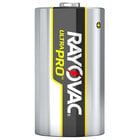
C Batteries
These heavy-duty batteries are mainly used for toys, flashlights, and portable radios.
Many automatic hand sanitizer dispensers require the use of these 1.5V batteries. Perfect for heavy-duty applications where batteries require frequent use, you can be sure that your device is operating with safe, reliable power. These batteries are also frequently used in restrooms that utilize battery powered flush sensors.
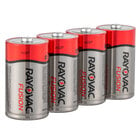
D Batteries
Used for devices that require an extended period of power time, these batteries work best in large flashlights, stereos, and hands-free soap or paper towel dispensers.
Powering most automatic paper towel dispensers, D batteries are essential. These large, bulky batteries provide hours of use and power a variety of commercial, heavy-use devices, like hands-free sensor faucets, air freshener systems, and soap dispensers.
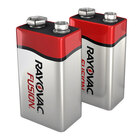
9V Batteries
Generally known for its rectangular shape, the 9-Volt battery is used in devices that require high voltage and lots of power.
9V batteries work extremely well for devices like infrared thermometers, battery powered temperature alarms, and electronic portion scales. These products may all encounter extreme temperatures from food, walk-in coolers, or other kitchen equipment. 9V batteries are exceptionally durable and offer outstanding performance, working in environments from 0 to 130 degrees Fahrenheit.
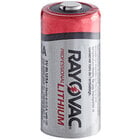
CR123A Batteries
Packed with power, this battery is frequently used for tactical equipment, wireless security, and home automation.
Although significantly shorter in length than a AA battery, the CR123A battery generates 3 volts—twice the voltage of a AA battery. These batteries deliver a huge amount of power while maintaining a relatively small size. Ideal for devices that require a lot of power, like LED flashlights, they ensure maximum performance. This battery will last longer than most, thanks to its large power-to-size ratio.
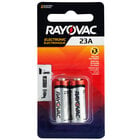
23A Batteries
This small battery is commonly used in small devices such as garage door openers, specialized medical devices, watches, or remotes.
Delivering 12 volts of power, it is used in applications that require infrequent but powerful bursts of energy. Previously used in photoflash film cameras, these batteries are now used primarily for garage door openers, wireless doorbells, and keyless entry devices.
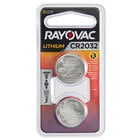
CR2032 Batteries
This small round battery offers a lot of power in a compact size, making it unique compared to most other batteries.
At 3 volts, the CR2032 battery is commonly used in watches, calculators, toys, and different medical devices. These batteries provide long-lasting, reliable power and have a very high weight-to-power ratio. Used in wrist watches and slim, compact thermometers, this battery is practically weightless while providing hours of use.
Battery Types
When choosing batteries, there are lots of things to consider. Different chemical constructions offer unique benefits depending on where the battery is being used. Outlined below are common battery types, along with the pros and cons of each.
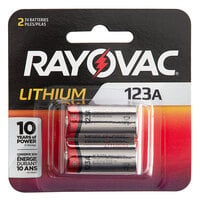
Lithium Batteries
Lithium batteries are one of the most commonly used battery types. They offer the highest energy density of any other battery cell, meaning they store more energy than other batteries, such as alkaline. Lithium batteries are only sold in AA, AAA, and 9V sizes; however, their mAh ratings exceed every other non-rechargeable battery. One AA lithium battery ranges from 2,700-3,400 mAh, and will last a long time, even under heavy-use.
- Last up to 4x longer compared to other battery types
- Light-weight for portable devices
- Ideal for heavy-use
- Function well even in extreme temperatures, working well in outdoor devices like flashlights
- Shelf life is 10-12 years; great for use in emergency devices, as the batteries will not leak or explode
- Much more expensive than other battery types
- Highly flammable; require special disposal at specified locations and cannot be thrown away
- Don’t come in bigger battery sizes like C or D

Alkaline Batteries
Alkaline batteries are economical, easy to dispose of, and extremely popular. They normally have a capacity rating of over 2,500 mAh, great for moderate to heavy-use devices. Unlike lithium batteries, almost every standard size battery offers an alkaline construction, making it perfect for most devices.
- Great price for quality
- Last longer due to potassium hydroxide construction
- Shelf life is 5-10 years
- Function well even in extreme temperatures, working well in outdoor devices like flashlights
- Lead, mercury, and cadmium-free is good for the environment, and the batteries don't need to be disposed of in a specific way
- Heavy and bulky, without additional voltage
- May not work well in high drain devices
- Will sometimes leak, causing the device to become unusable

Carbon Zinc Batteries
Carbon zinc batteries are extremely inexpensive, but have a very low energy density. Oftentimes, these batteries won’t be able to supply enough power to a high-drain device beyond merely turning it on.
- Inexpensive and easy to find
- Multiple different shapes and sizes are readily available
- Low energy density
- Unable to perform well in extreme temperatures
- Will not be able to efficiently power high drain devices
- Shelf life is 2-3 years
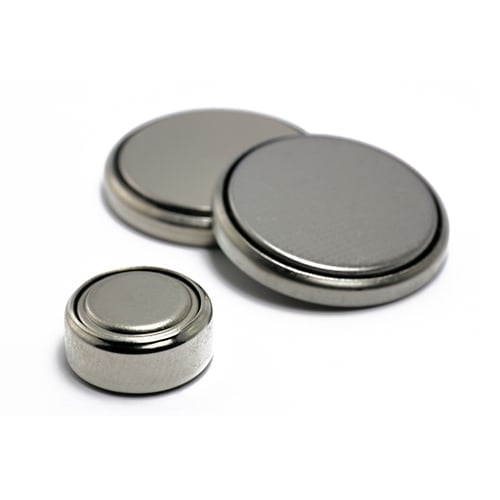
Silver Oxide Batteries
Silver oxide batteries are commonly used in wrist watches and other small devices. Because the battery is constructed of real silver, it is often sold only in button cells where the amount of silver is insignificant to the overall cost of the product.
- High energy-to-weight ratio
- Exceptionally long operating life
- Flat construction works well in compact devices
- Provides up to twice the amount of energy capacity compared to similar alkaline button type batteries
- Expensive material deters use in high power applications
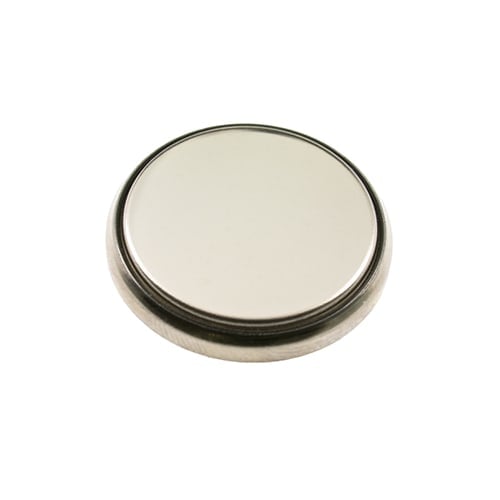
Zinc Air Batteries
Zinc air batteries are unique in their construction, as they generate electrical power through exposure to oxygen. This makes them unfit for wrist watches, but perfect for hearing aids. Activating the battery requires a user to remove a sealing tab from the battery, enabling airflow.
- High energy density for devices like hearing aids
- Inexpensive
- Act as a replacement for highly toxic, and mostly obsolete, mercury batteries
- Sensitive to extreme temperatures and humidity
- Dry out once exposed to outside air, reducing battery life
Rechargeable Battery Types
Rechargeable batteries are a cost-effective solution that work to save you money in the long run. Best paired with devices that use high power frequently, rechargeable batteries come in many different shapes and sizes. Although consumer sizes, like AA and AAA batteries are commonly used, lithium-ion batteries are the ones that are most prevalent. These batteries power laptops, cell phones, and portable electronic devices as well as medical equipment and power tools.
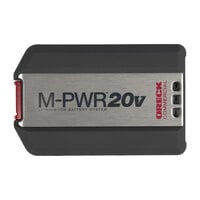
Lithium-ion
Lithium-ion batteries, also frequently referred to as li-ion, are the most popular and regularly used batteries in today’s world. Although you may not realize what kind of battery powers your mobile phone or laptop, chances are it’s a li-ion battery. These batteries are a type of rechargeable battery and can be recharged over and over again. They do not require regular maintenance, and provide an extremely high energy density. Li-ion batteries are not available in consumer sizes because they could explode if placed in a regular device used to recharge batteries. Instead, they require a special kind of charger with a specific lithium-ion charge algorithm.
- Small and thin with superior energy density; most smartphones use li-ion batteries
- Quick to recharge, and fairly low self-discharge. A li-ion battery loses less than 5% of its full charge per month, compared to NiMH at up to 20% per month.
- Does not require a prolonged charge when new, compared to other rechargeable batteries. One charge is all you need.
- Maximum performance and efficiency offset high initial costs making it consumer friendly
- Environmentally friendly and safe
- Not available in regular household sizes
- Requires protection circuit to prevent over-heating and limit voltage
- Overall capacity will slowly deteriorate over time, causing the device to lose its charge quicker
- Use a specific type of charger, requiring a user to purchase one or have one on hand
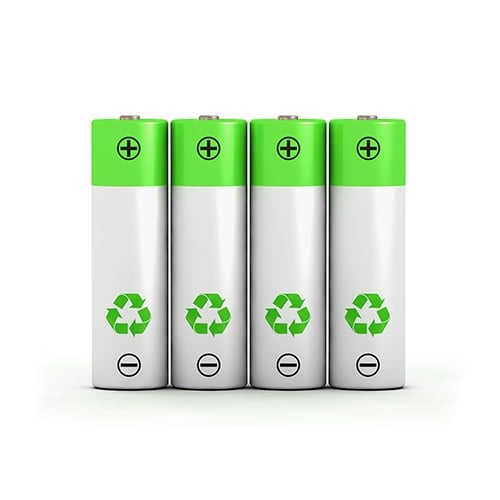
NiCd
NiCd batteries, or nickel cadmium, are a popular choice for toys, digital cameras, or other high-drain devices like flashlights. They come in standard sizes, like AA, AAA, C, and 9V. NiCd batteries are unique compared to other batteries, such as alkaline, in that they will maintain a steady voltage up until the battery is depleted. With 1.2V per cell, it does not have a high voltage, but the powerful delivery makes up for this. For example, you can tell when a flashlight is dying, as the lightbulb will slowly dim. With NiCd batteries, the brightness will remain constant, until the battery’s power is depleted.
- Inexpensive and easy to find
- Low internal resistance ensures the battery charges and discharges quickly
- Delivers at full capacity
- Does not store well over long periods of time
- A full-discharge is required before recharging or the battery will lose its capacity
- Over-charging will cause the battery’s capacity to decline
- Contains toxic metals and is not environmentally friendly
- Uses a specific type of charger, requiring a user to purchase one or have one on hand
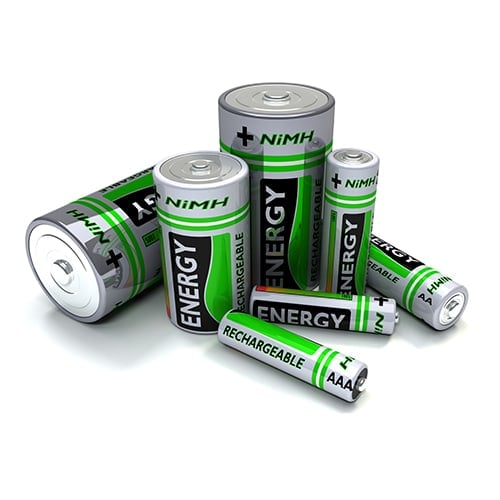
NiMH
Although NiMH batteries are labeled as high-density, this can come at the expense of a reduced cycle life. They have a high energy density, but can only be recharged about 500 times. While they will certainly pay for themselves over time, they may not be the best choice for applications like smoke alarms, TV remotes, or clocks. All of these devices draw very low energy, and a NiMH battery is best used within a 30-day period. Like NiCd batteries, NiMH batteries will deliver at full capacity until almost all of the energy has been discharged.
- High energy-to-volume ratio, compared to NiCd
- Environmentally friendly
- Delivers at full capacity
- Ship in a discharged state and require a full charge before use
- Over-charging will cause the battery's capacity to decline
- Discharges at a very high rate and must be recharged before use
- Doesn't perform well in high-rate discharge devices
Specialty Batteries
These large, heavy batteries are used for heavy equipment that require huge amounts of energy. They are commonly used in lawn mowers, power tools, and generators and provide long-lasting power in between charges.

12V; 12 Volt Battery
Large, block-shaped, and heavy, this battery provides hundreds of amps of electrical current and is commonly used in cars and other industrial equipment. Compared to some of the bigger voltage batteries, it might not make sense that a car is able to function with only 12 volts while other heavy equipment requires much more than just 12 volts. This is because heavy equipment and cordless power tools all require a charge after their energy has been depleted. Cars use an alternator which acts as a generator to keep the car's battery powered, eliminating the need for an external charger.
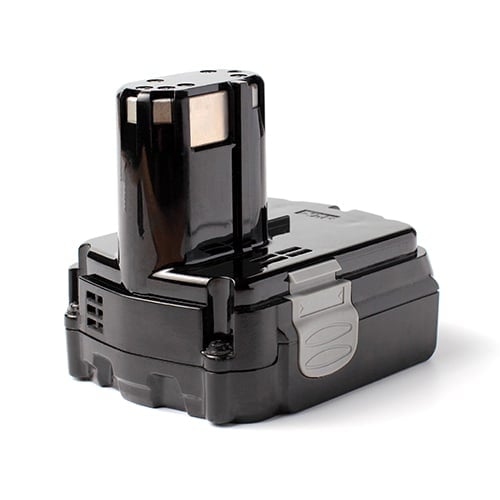
22V; 22 Volt Battery
At 22 volts, this battery is used to power heavy equipment and high-power cordless tools like drills and electric saws. Because cordless power tools are compact, but require a great deal of energy, 22V batteries are perfect for the job. They deliver high power for an extended period of time, such as when installing electrical appliances.

44V; 44 Volt Battery
With an enormous voltage rating of 44 volts, this battery powers equipment that consumes power, like cordless power washers, leaf blowers, and self-propelled lawn mowers. All of these use up a huge amount of energy because not only are they in constant use, they are also high-powered.
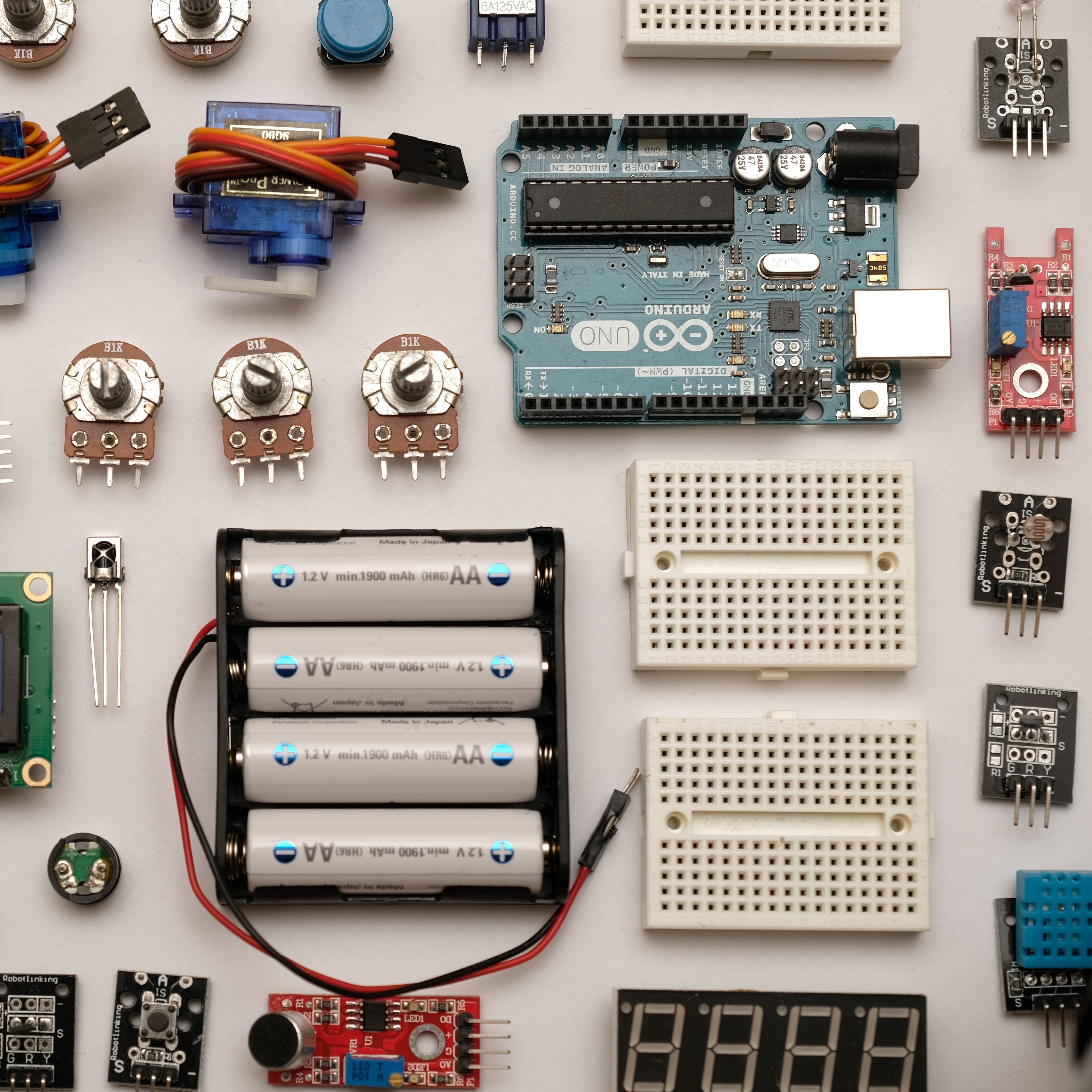
How Batteries Work
Before getting into the different chemical constructions of the different types of batteries, it’s important to have some general knowledge about how batteries work since they are measured a bit differently than other electrical appliances.
Capacity: Capacity refers to the amount of charge a battery holds. It is measured in milliamp-hours (mAh), or amp-hours (aH). A battery’s mAh is normally listed on the side of the battery, and you can figure out how long you can expect the battery to last using this simple equation:
Amp Hours (aH) / Amps (A) = Hours (H)
For example, a 2,500 mAh AA alkaline battery could power a device that draws 250 mA of current for 10 hours. However, if the load draws 25 mA of current, the battery will last 100 hours. The overall life of your battery depends on what you use it for, but a general rule of thumb is that the higher mAh a battery has, the longer it will retain its energy.
Related Resources

Emergency Supplies List For Businesses
A part of overall restaurant safety is to ensure that you have a business disaster plan in place to help protect your employees and customers in the event of an emergency. Whether it's a fire, an extended power outage, or a natural disaster, having the proper emergency supplies available can sometimes impact survival. Being properly prepared can even affect the overall success of your business after the emergency has passed. We have created an emergency supplies checklist to help your business prepare for unpredictable circumstances. Shop All Emergency Supplies Click below for a downloadable emergency preparedness supplies checklist: Download our Emergency Supplies Checklist PDF Emergency Supplies The Federal Emergency Management Agency (FE
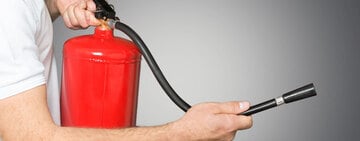
Types of Fire Extinguishers
Having a fire extinguisher is crucial to the safety of your restaurant, employees, and customers. It is important that you understand the different types of fire extinguishers as well as the associated components and terminology so you can choose the fire extinguisher that's right for your operation. Be sure to check out our fire extinguisher reviews as well!
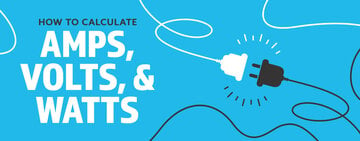
How to Calculate Amps, Volts, and Watts
If your kitchen equipment isn't working properly, it's time to check the electrical requirements. Operators hooking commercial kitchen equipment to the wrong voltage is the No. 1 reason for its malfunction. Prevent this by identifying the volts, amps, and watts of your foodservice machinery and confirming their compatibility with your building's utilities. If you only have two of those electrical ratings, you can calculate the missing data. We provide a calculator that instantly converts amps to watts or volts, and we also offer a series of electrical conversation formulas so you can calculate the conversions yourself.
- Topics 1356
- Industrial 55
- Troubleshooting Guides 21
- Restaurant Management 128
- Bar Management 56
- Catering Tips 36
- Bakery Management 42
- Food Trucks & Concessions 49
- Advertising & Marketing 37
- Eco-Friendly Tips 11
- Facility Layout & Design 42
- Coffee Shop Tips 28
- Installation & Maintenance 51
- Janitorial & Pest Control 30
- Safety & Sanitation 88
- Startup Tips 104
- Menu Design 10
- Kitchen & Cooking Tips 83
- Hospitality Management 24
- Pizza & Sandwich Shop Tips 36
- Smallwares 37
- Food Prep 89
- Tabletop Items 17
- Disposables 22
- Calculators & Tools 6
- Consumables 52
- Warewashing & Laundry 19
- Cooking Equipment 91
- Food Storage & Refrigeration 51
- Beverage Equipment 35
- Office Supplies 6
- Resource Type
- In-Depth Articles272
- Buying Guides298
- How-Tos95
- Product Reviews78


